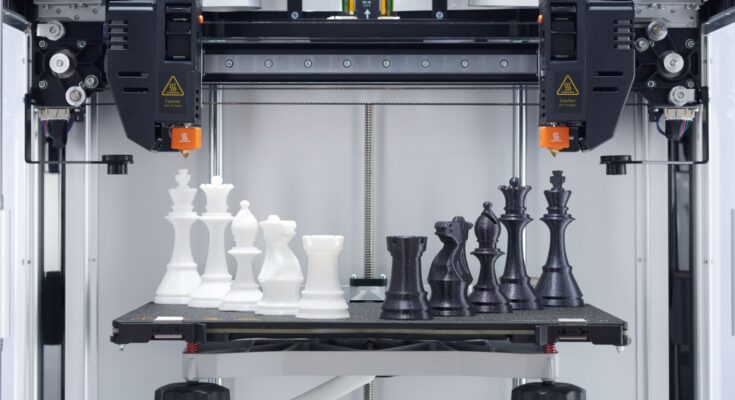In the world of 3D printing, material selection is as critical as the printer itself. The type of material you choose directly influences the durability, appearance, functionality, and application of your prints. This guide explores the most popular 3D printing materials, their properties, and common applications to help you optimize your projects. Whether you’re using the best 3D printer for beginners or professionals, understanding materials is key to achieving your goals.
Common Types of 3D Printing Materials
1. Plastics
Plastics dominate the 3D printing market due to their versatility, cost-effectiveness, and ease of use.
PLA (Polylactic Acid)
- Properties: Biodegradable, low melting temperature, minimal warping.
- Applications: Ideal for beginners, hobby projects, and aesthetic models.
- Pros: Easy to print, eco-friendly.
- Cons: Low heat resistance, limited strength.
ABS (Acrylonitrile Butadiene Styrene)
- Properties: Tough, durable, higher melting point.
- Applications: Prototypes, mechanical parts, automotive applications.
- Pros: Strength and flexibility.
- Cons: Prone to warping; requires a heated bed.
PETG (Polyethylene Terephthalate Glycol)
- Properties: Strong, heat-resistant, food-safe.
- Applications: Functional parts, containers, outdoor use.
- Pros: Balances strength and flexibility.
- Cons: Slightly more difficult to print than PLA.
2. Resins
Resin-based materials are used primarily in SLA (stereolithography) or DLP (digital light processing) 3D printers.
Standard Resin
- Properties: High detail, smooth surface finish.
- Applications: Miniatures, prototypes, and artistic models.
- Pros: Excellent for intricate designs.
- Cons: Brittle and less durable.
Tough Resin
- Properties: Greater impact resistance and strength.
- Applications: Functional parts that need durability.
- Pros: More robust than standard resin.
- Cons: More expensive.
Flexible Resin
- Properties: Rubber-like flexibility.
- Applications: Wearables, seals, and gaskets.
- Pros: Unique elastic properties.
- Cons: Limited use cases.
3. Composites
Composite filaments are infused with materials like carbon fiber, wood, or metal.
Carbon Fiber-Infused Filament
- Properties: Lightweight, incredibly strong, and rigid.
- Applications: Aerospace and automotive parts.
- Pros: High strength-to-weight ratio.
- Cons: Abrasive; may require hardened nozzles.
Wood Filament
- Properties: Mimics the appearance and feel of wood.
- Applications: Decorative and aesthetic projects.
- Pros: Unique finish.
- Cons: Fragile; not suitable for functional parts.
Metal-Filled Filament
- Properties: Heavy, metallic appearance.
- Applications: Jewelry, artistic models.
- Pros: Polishable for a metal-like shine.
- Cons: Denser and more expensive.
4. Specialty Materials
For advanced users with specific needs, specialty materials can elevate prints to the next level.
TPU (Thermoplastic Polyurethane)
- Properties: Flexible, impact-resistant.
- Applications: Wearables, phone cases, seals.
- Pros: Great elasticity and durability.
- Cons: Challenging to print.
Nylon
- Properties: Strong, abrasion-resistant, and flexible.
- Applications: Functional parts, gears, and tools.
- Pros: High durability.
- Cons: Hygroscopic (absorbs water).
PVA (Polyvinyl Alcohol)
- Properties: Water-soluble.
- Applications: Support structures in multi-material prints.
- Pros: Dissolves easily for clean finishes.
- Cons: Limited shelf life.
Matching Materials to Applications
Artistic and Aesthetic Prints
- Best Choices: PLA, standard resin, wood filament.
- Why: These materials prioritize surface finish and ease of use.
Functional and Mechanical Parts
- Best Choices: ABS, PETG, nylon, carbon fiber filament.
- Why: High durability and resistance to stress are essential.
Prototyping
- Best Choices: PLA for initial models; ABS or PETG for functional prototypes.
- Why: Balance between cost and performance.
Key Considerations When Choosing Materials
Printer Compatibility
Some materials require specific conditions, such as a heated bed or enclosed chamber. Ensure your printer supports the material.
Post-Processing Needs
Materials like resin may require curing, while others like wood filament may need sanding or staining for the desired effect.
Cost vs. Value
Balance the price of the filament or resin with its durability and performance for the intended project.
Environmental Factors
For outdoor use, choose materials like PETG that can withstand UV and weather exposure.
Printing Skill Level
Beginners may prefer PLA, while advanced users can explore nylon or composite materials for complex needs.
Enhancing Prints with the Best 3D Printer
Even with the best materials, your results depend on the printer’s capabilities. The best 3D printers offer precision, material compatibility, and advanced features like heated beds or dual extrusion to support multi-material prints. Investing in a reliable machine ensures smoother prints and fewer material limitations.
Conclusion
Selecting the right material is a cornerstone of 3D printing success. By understanding the properties and applications of various materials—PLA for simplicity, ABS for durability, resin for detail—you can unlock endless possibilities. Pair your choice with the best 3D printer, and you’ll be equipped to tackle projects ranging from artistic miniatures to functional prototypes. As technology evolves, so too will the materials and their applications, expanding the horizons of 3D printing creativity.




